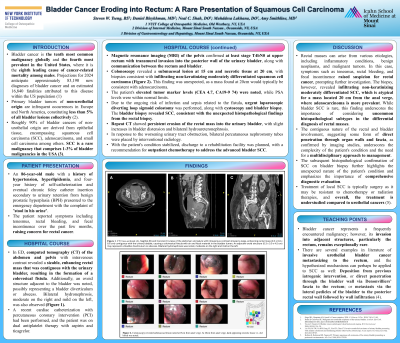Tuesday Poster Session
Category: Colon
P3717 - Bladder Squamous Cell Carcinoma Diagnosed by Colonoscopy
Tuesday, October 29, 2024
10:30 AM - 4:00 PM ET
Location: Exhibit Hall E

Has Audio

Steven W. Tseng, BS
New York Institute of Technology College of Osteopathic Medicine
Little Neck, NY
Presenting Author(s)
Daniel Bleykhman, MD1, Steven W. Tseng, BS2, Neal Shah, DO1, Muhddesa Lakhana, DO1, Amy Smithline, MD3
1Mount Sinai South Nassau, Icahn School of Medicine at Mount Sinai, Oceanside, NY; 2New York Institute of Technology College of Osteopathic Medicine, Little Neck, NY; 3Mount Sinai South Nassau Hospital, Oceanside, NY
Introduction: We present a case of rectal invasion by squamous cell carcinoma of the bladder in an elderly male. Primary bladder tumors of non-urothelial origin account for less than 5% of all bladder lesions in Europe and North America. Squamous cell carcinoma (SCC), constitutes 1-3% of bladder malignancies in the USA. Risk factors include chronic or recurrent urinary tract infections (UTIs), bladder calculi, pelvic radiation therapy (RT), intravesical Bacillus Calmette-Guerin (BCG) treatment, and prolonged cyclophosphamide exposure. Bladder SCC rarely invades adjacent structures such as the rectum, contributing to a challenging and surprising diagnosis during our patient’s hospital course.
Case Description/Methods: An 86-year-old male with a history of chronic foley catheter insertion due to urinary retention presented with "stool in his urine." He reported tenesmus, rectal bleeding, and fecal incontinence. CT imaging showed a large rectal mass contiguous with the bladder, forming a colovesical fistula, and a possible bladder diverticulum or abscess. MRI confirmed rectal involvement with bladder invasion. Colonoscopy identified a submucosal lesion and necrotic tissue. Biopsies showed non-keratinizing moderately differentiated SCC. Elevated tumor markers (CEA 4.7, CA19-9 74) were noted, with normal PSA levels. Urgent cystoscopy with bladder biopsy confirmed SCC origin, and a laparoscopic diverting loop sigmoid colostomy along with bilateral nephrostomies was created. Urgent surgical intervention was crucial in managing the risk of infection and sepsis. The patient was eventually discharged with planned outpatient chemotherapy.
Discussion: Our case highlights the complex interplay of patient comorbidities and unexpected histopathological findings. The patient's presentation raised initial concerns for rectal adenocarcinoma; however, biopsies revealed SCC, a rare finding at this anatomical location. The direct penetration of the bladder cancer into the rectum underscores the importance of considering uncommon histopathological subtypes in differential diagnoses. The value of comprehensive diagnostic evaluation and a coordinated treatment strategy is demonstrated here. Currently, literature does not have any similar documentations of a rectal mass with an unexpected Bladder SCC identity.
Disclosures:
Daniel Bleykhman, MD1, Steven W. Tseng, BS2, Neal Shah, DO1, Muhddesa Lakhana, DO1, Amy Smithline, MD3. P3717 - Bladder Squamous Cell Carcinoma Diagnosed by Colonoscopy, ACG 2024 Annual Scientific Meeting Abstracts. Philadelphia, PA: American College of Gastroenterology.
1Mount Sinai South Nassau, Icahn School of Medicine at Mount Sinai, Oceanside, NY; 2New York Institute of Technology College of Osteopathic Medicine, Little Neck, NY; 3Mount Sinai South Nassau Hospital, Oceanside, NY
Introduction: We present a case of rectal invasion by squamous cell carcinoma of the bladder in an elderly male. Primary bladder tumors of non-urothelial origin account for less than 5% of all bladder lesions in Europe and North America. Squamous cell carcinoma (SCC), constitutes 1-3% of bladder malignancies in the USA. Risk factors include chronic or recurrent urinary tract infections (UTIs), bladder calculi, pelvic radiation therapy (RT), intravesical Bacillus Calmette-Guerin (BCG) treatment, and prolonged cyclophosphamide exposure. Bladder SCC rarely invades adjacent structures such as the rectum, contributing to a challenging and surprising diagnosis during our patient’s hospital course.
Case Description/Methods: An 86-year-old male with a history of chronic foley catheter insertion due to urinary retention presented with "stool in his urine." He reported tenesmus, rectal bleeding, and fecal incontinence. CT imaging showed a large rectal mass contiguous with the bladder, forming a colovesical fistula, and a possible bladder diverticulum or abscess. MRI confirmed rectal involvement with bladder invasion. Colonoscopy identified a submucosal lesion and necrotic tissue. Biopsies showed non-keratinizing moderately differentiated SCC. Elevated tumor markers (CEA 4.7, CA19-9 74) were noted, with normal PSA levels. Urgent cystoscopy with bladder biopsy confirmed SCC origin, and a laparoscopic diverting loop sigmoid colostomy along with bilateral nephrostomies was created. Urgent surgical intervention was crucial in managing the risk of infection and sepsis. The patient was eventually discharged with planned outpatient chemotherapy.
Discussion: Our case highlights the complex interplay of patient comorbidities and unexpected histopathological findings. The patient's presentation raised initial concerns for rectal adenocarcinoma; however, biopsies revealed SCC, a rare finding at this anatomical location. The direct penetration of the bladder cancer into the rectum underscores the importance of considering uncommon histopathological subtypes in differential diagnoses. The value of comprehensive diagnostic evaluation and a coordinated treatment strategy is demonstrated here. Currently, literature does not have any similar documentations of a rectal mass with an unexpected Bladder SCC identity.
Disclosures:
Daniel Bleykhman indicated no relevant financial relationships.
Steven Tseng indicated no relevant financial relationships.
Neal Shah indicated no relevant financial relationships.
Muhddesa Lakhana indicated no relevant financial relationships.
Amy Smithline indicated no relevant financial relationships.
Daniel Bleykhman, MD1, Steven W. Tseng, BS2, Neal Shah, DO1, Muhddesa Lakhana, DO1, Amy Smithline, MD3. P3717 - Bladder Squamous Cell Carcinoma Diagnosed by Colonoscopy, ACG 2024 Annual Scientific Meeting Abstracts. Philadelphia, PA: American College of Gastroenterology.
